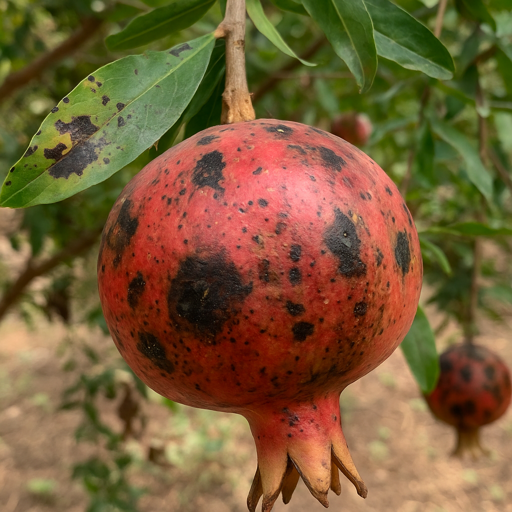What is Telya Disease in Pomegranate?
Telya disease, also called oil disease or तेल्या रोग, is a serious problem that affects pomegranate trees. In this disease, dark oily spots appear on leaves, fruits, and branches. These spots may spread and cause the leaves to turn yellow and fall off. The fruits become black or sticky and drop before ripening, leading to heavy loss. It is caused by a combination of unhealthy soil, poor farm practices, and bacteria that grow well in warm and humid weather. Once this disease enters the orchard, it spreads quickly if not controlled on time.
Telya disease makes the plant weak and reduces fruit quality and size. If not treated, it can destroy a large portion of your crop. Early detection and proper treatment are very important. Farmers should learn how to identify the symptoms and follow good practices to prevent this disease.
Why Does Telya Disease Happen?
Here are the main reasons why pomegranate trees get this disease:
- Hot and Humid Weather
- When the weather is warm (28–32°C) and air is humid (above 70%), the disease spreads fast.
- When the weather is warm (28–32°C) and air is humid (above 70%), the disease spreads fast.
- Using Infected Plants
- If you plant saplings from trees already infected with oil disease, the new plants will also get it.
- If you plant saplings from trees already infected with oil disease, the new plants will also get it.
- Too Much Nitrogen Fertilizer
- Rainwater, air, and even canal/river water already contain nitrogen.
- Too much nitrogen from fertilizers weakens the plant and attracts disease.
- Rainwater, air, and even canal/river water already contain nitrogen.
- High Chloride in Soil
- Water and fertilizers can add too much chloride to the soil, which is harmful.
- Water and fertilizers can add too much chloride to the soil, which is harmful.
- Poor Soil Health
- Less organic matter and overuse of chemical fertilizers reduce soil health.
- If organic carbon is less than 0.6%, the plant becomes weak.
- Less organic matter and overuse of chemical fertilizers reduce soil health.
- Injuries to Plants
- When you prune, remove water shoots, or use machines like blowers or trolleys, plants get injured.
- Hailstorms or too much nitrogen can also damage plants.
- When you prune, remove water shoots, or use machines like blowers or trolleys, plants get injured.
- Weak Plants
- If plants don’t get enough nutrients or are attacked by soil worms (nematodes), they become weak and easily infected.
- If plants don’t get enough nutrients or are attacked by soil worms (nematodes), they become weak and easily infected.
- Dirty Tools
- Using the same pruning tools on different trees without cleaning spreads the disease.
How to Control Telya Disease – SV Agro Solutions' Simple Plan
1. Before Planting
- Use healthy saplings from disease-free nurseries.
- Don’t buy plants from gardens with oil disease history.
2. During Pruning or Injury
- Always clean and sterilize tools before use.
- After pruning or removing tops, spray SV Rounder P – 2.5 g per liter of water.
- For soil problems like nematodes or disease, apply SV Rounder P to the soil with the first watering.
3. When Fruit Changes Color
- Apply SV Rounder P (1 kg per acre) + SV Excitum (1 kg per acre).
- Do this twice – once when the fruit is green and once when it turns red.
4. During Wet and Humid Conditions
- In rainy or humid days, spray alternate doses of:
SV Rounder P + Rounder L
- SV Defense
- SV Defense
5. Nutrient and Soil Management
- Don’t give too much nitrogen. Count nitrogen from rain, water, and soil bacteria.
- Use green manure and sugarcane mulch to keep soil healthy.
- Apply SV Fruiter (100–150 kg per acre) with SV 59 + SVK drip to increase organic matter.
- If soil becomes salty, use SV Terminus (1 liter per acre every 2 months).
- In limestone soils, give extra sulfur, phosphorus, and manganese.
6. Long-Term Prevention
- Start using SV Agro's schedule early in orchards already affected by telya disease.
If you follow this simple schedule and check your soil and plants regularly, you can prevent telya disease and grow healthy pomegranate fruits with better yield and income.
